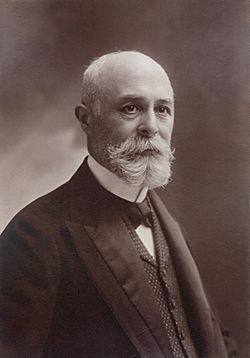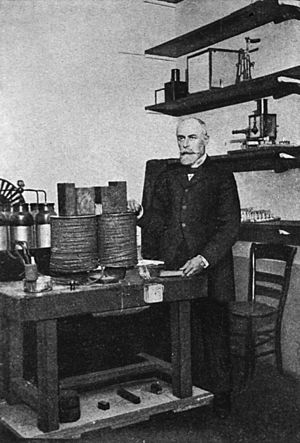Henri Becquerel facts for kids
Quick facts for kids
Henri Becquerel
|
|
|---|---|

Henri Becquerel c. 1905
|
|
| Born | 15 December 1852 Paris, France
|
| Died | 25 August 1908 (aged 55) Le Croisic, Brittany, France
|
| Alma mater | École Polytechnique École des Ponts et Chaussées |
| Known for | Discovery of radioactivity |
| Awards |
|
| Scientific career | |
| Fields | Physics, chemistry |
| Institutions | Conservatoire des Arts et Metiers École Polytechnique Muséum National d'Histoire Naturelle |
| Thesis | Recherches sur l'absorption de la lumière |
| Doctoral advisor | Charles Friedel |
| Doctoral students | Marie Skłodowska-Curie |
| Signature | |
| Notes | |
|
He is the father of Jean Becquerel, son of Edmond Becquerel, and grandson of Antoine César Becquerel
|
|
Antoine Henri Becquerel (born December 15, 1852 – died August 25, 1908) was a French scientist. He was an engineer and a physicist. He is famous for being the first person to discover radioactivity. This is when certain materials give off energy in the form of rays.
For his amazing work, he shared the 1903 Nobel Prize in Physics with Marie Curie and Pierre Curie. The scientific unit for measuring radioactivity, called the becquerel (Bq), is named after him.
Contents
About Henri Becquerel
His Early Life and Family
Henri Becquerel was born in Paris, France. He came from a very smart family. His grandfather, father, and son were all famous physicists too! This means science ran in his family for four generations.
Henri went to a special prep school in Paris called Lycée Louis-le-Grand. After that, he studied engineering at two important schools: École Polytechnique and École des Ponts et Chaussées.
In 1874, Henri married Lucie Zoé Marie Jamin. Sadly, she passed away while giving birth to their son, Jean. Later, in 1890, Henri married Louise Désirée Lorieux.
His Scientific Career
Early in his career, Henri Becquerel followed in his family's footsteps. In 1892, he became the third Becquerel to hold a physics job at the National Museum of Natural History, France. Before his big discoveries, he also worked as a chief engineer.
His first research focused on how light behaves. He studied how light travels and how certain crystals absorb or glow after being exposed to light. He also looked into the Earth's magnetic field.
The Discovery of Radioactivity
Henri Becquerel's most famous discovery was spontaneous radioactivity. This happened by chance, which is often how big scientific breakthroughs occur! He was very interested in something called phosphorescence. This is when a material glows after being exposed to light.
In early 1896, everyone was excited about X-rays. These invisible rays were discovered by Wilhelm Röntgen. They could pass through things like paper. Becquerel wondered if materials that glowed (phosphorescent materials), like some uranium salts, might also give off X-ray-like radiation when exposed to sunlight.
He did an experiment with uranium salts. He put them on photographic plates, which are like old-fashioned film. He wrapped the plates in black paper to keep light out. He thought the sunlight would make the uranium glow and produce X-rays.
One day, the weather was cloudy, so he couldn't do his experiment. He put his uranium salts and wrapped photographic plates away in a drawer. A few days later, he decided to develop the plates anyway. To his surprise, the plates were exposed, just as if they had been in the sun!
This meant the uranium was giving off rays all by itself, without needing sunlight. This was a huge moment! It showed that the radiation came directly from the uranium. This was the discovery of radioactivity.
After this, many scientists, including Marie Curie and Pierre Curie, started studying radioactivity. They found other radioactive elements like thorium, polonium, and radium. Becquerel published seven papers about radioactivity in 1896 alone. He also found that radioactive rays could be affected by a magnetic field. Some rays bent one way, some bent the other, and some didn't bend at all. This showed there were different types of radiation.
Later Discoveries and Legacy
Later in his life, around 1900, Becquerel studied Beta Particles. He found that these particles were actually high-speed electrons coming from the center of atoms.
In 1901, he made another important discovery. He realized that radioactivity could be used in medicine! He accidentally left a piece of radium in his pocket and noticed it caused a burn on his skin. This observation led to the development of radiotherapy. Today, radiotherapy is used to treat diseases like cancer.
Henri Becquerel passed away on August 25, 1908, when he was 55 years old. The exact cause of his death is not known. However, it was reported that he had severe burns on his skin, likely from handling radioactive materials. His work changed our understanding of the atom and opened up new fields of science and medicine.
Honors and Awards
Henri Becquerel received many awards for his amazing discoveries.
- In 1889, he became a member of the French Academy of Sciences.
- In 1900, he won the Rumford Medal for discovering uranium's radioactivity. He was also made an Officer of the Legion of Honour.
- In 1901, he received the Helmholtz Medal.
- In 1903, he shared the Nobel Prize in Physics with Pierre Curie and Marie Curie. This was for their discovery of spontaneous radioactivity.
- In 1905, he was given the Barnard Medal.
The SI unit for radioactivity is called the becquerel (Bq), named in his honor. There are also craters named Becquerel on the Moon and Becquerel on Mars. A mineral containing uranium, called becquerelite, is also named after him. Even a minor planet, 6914 Becquerel, carries his name!
See also
- Antoine César Becquerel (his grandfather)
- A. E. Becquerel (his father)
- Jean Becquerel (his son)
- Becquerelite (mineral)
- Becquerel (SI unit)
 In Spanish: Henri Becquerel para niños
In Spanish: Henri Becquerel para niños



